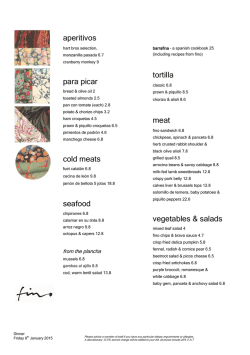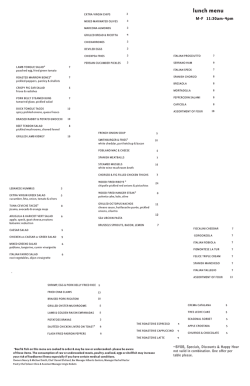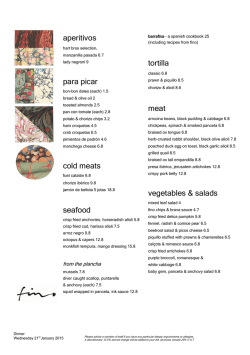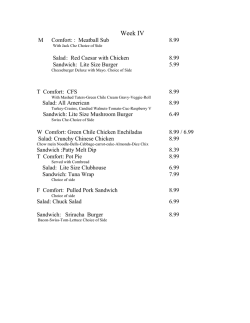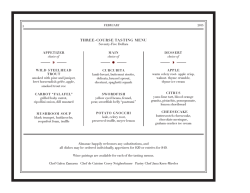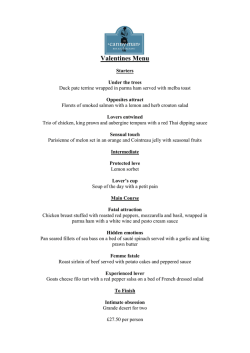
Evaluation of the Degree of Contamination of Salad Vegetables
American Journal of Microbiological Research, 2015, Vol. 3, No. 1, 41-44 Available online at http://pubs.sciepub.com/ajmr/3/1/6 © Science and Education Publishing DOI:10.12691/ajmr-3-1-6 Evaluation of the Degree of Contamination of Salad Vegetables Sold in Umuahia Main Market Nwankwo. I.U, Eze. V.C, Onwuakor. C.E*, Friday. J.U Department of Microbiology, College of Natural Sciences, Michael Okpara University of Agriculture Umudike, Abia State, Nigeria. *Corresponding author: [email protected] Received November 27, 2014; Revised January 14, 2015; Accepted February 01, 2015 Abstract The evaluation of the degree of contamination of salad vegetables sold in Umuahia main market was carried out. Six Samples of salad vegetables (Cabbage, Carrot, Cucumber, Onions, Green peas and Green beans) sold around the market were analyzed. Total viable counts ranged from 2.35 x 105 to 9.50 x 105 cfu/ml with highest incidence seen in cabbage and onions sold by vendor A. 86.66% of cabbage samples were contaminated, with the least incidence seen in green bean (33.33%). Six bacterial and five fungal species were isolated. The isolates include: Staphylococcus aureus, Escherichia coli, Pseudomonas aeruginosa, Bacillus sp, Enterobacter sp and Proteus sp. and the fungal isolates were Aspergillus sp. Yeast, Cladosporium sp. Penicillium sp. and Rhizopus sp. These results indicates that street vended salad vegetables where contaminated to an extent, and therefore, needs vigorous washing with safe running water before consuming to avoid food borne diseases associated with consumption of contaminated food. Keywords: Evaluation, Degree Of Contamination, Salad Vegetables, Umuahia, Market Cite This Article: Nwankwo. I.U, Eze. V.C, Onwuakor. C.E, and Friday. J.U, “Evaluation of the Degree of Contamination of Salad Vegetables Sold in Umuahia Main Market.” American Journal of Microbiological Research vol. 3, no. 1 (2015): 41-44. doi: 10.12691/ajmr-3-1-6. 1. Introduction Salad is a term broadly applied to many food preparations that have a mixture of chopped or sliced ingredients which may be mainly vegetables [1]. Salad vegetables are consumed without any form heat treatment, sometimes without washing, thus, has the possibility of causing food borne diseases. Salads containing raw vegetables have been identified as vehicles of traveler’s diarrhea, an illness sometimes experienced by visitors in developing countries [2,3]. Vegetables serve a major part of our food supply. Raw vegetables sometimes harbor a number of pathogenic microorganisms [4]. During harvesting and transportation, raw vegetables may be bruised resulting in the release of plant nutrients and thereby, providing substrates for microorganisms present on the surface of the vegetable to grow. In addition, the processing of fresh salad vegetables may affect or increase the number and type of pathogen present on the surface of the product. Vegetables have been associated with the outbreaks of food borne diseases in many countries due to exposure to pathogens [5]. The microbial flora of partially processed foods as found in pre-packed mixed vegetables salads should be of great concern since both food spoilage and safety are involved. The presence or absence as well as the fate of both human pathogens and plant tissue spoilage organisms are important. Vegetables are extraordinary dietary source of nutrients, micronutrients, vitamins and fibre for humans and are thus, vital for health and well being. Well balanced diets, rich in vegetables are especially valuable for their ability to prevent vitamin C and vitamin A deficiencies and are also reported to reduce the risk of several forms of diseases [6]. Freshly cut vegetables are minimally processed by washing, slicing, peeling and shredding prior to sale. Leafy vegetables such as cabbage and lettuce are most common products in the fresh cut vegetable category. The processing of salad vegetables by slicing and cutting has little effect on the vegetable tissues, however these processes may alter or increase the number and type of microorganisms present on the surface of the product. Washing in sanitized water is sometimes used to reduce the number of microorganisms present. In addition, some cut vegetables are packaged under Modified Atmospheric Packaging (MAP) and refrigerated to extend the shelf life. Proper washing of vegetables is essential for the reduction of microorganisms associated with the vegetable [7]. Vegetables are widely exposed to microbial contamination through contact with soil, dust and water from handling at harvest or during post-harvest processing. They, therefore habour a diverse range of microorganisms including plant and human pathogens [7]. Differences in microbial profiles of various vegetables result largely from unrelated factors such as resident microflora in the soil, inoculation of non-resident microflora via animal manures, sewage or irrigation water, transportation methods and handling by individual retailers [8,9]. 42 American Journal of Microbiological Research Vegetables have been cherished for their nutritional values. They provide little protein and fat. Apart from being rich in crude fibres, they contain water soluble vitamins including vitamin A and vitamin D. They also contain carbohydrates and minerals. Fresh produce, provide anti-oxidants and some other compounds that may lower the risk of cancer and other chronic diseases such as heart diseases, thus are important part of a healthy diet [9]. Salad vegetables pick microorganisms from the soil where they were planted, the manure used to improve the quality of the soil and water used for irrigation purposes. When these vegetables are consumed raw, there is a huge chance of endangering the health of consumers especially when the microorganisms present are pathogenic. The aim of this work is therefore to evaluate the level at which the salad vegetables sold in Umuahia main Market are contaminated. 2. Materials and Methods 2.1. Collection of Samples The salad vegetables were obtained from Umuahia central market by random sampling. Fifteen samples were collected for each of the salad vegetables (cabbage, carrot, cucumber, Green pea, Green beans and onion) from four different vendors. The samples were collected exactly as they were displayed for sale in the market and put in sterilized (by irradiation) polyethylene bags and taken to the laboratory for analysis. 2.2. Isolation of Microorganisms From each salad sample, 25 g was aseptically weighed and rinsed in 250 ml beaker containing 100 ml of sterile distilled water. Serial dilution was carried out using the sterile distilled water as diluents. 1 ml of the sample rinsed water was mixed with 9 mls of sterile distilled water in a test tube, it was mixed very well, and then 1 ml portion of it was transferred aseptically into another test tube containing 9 mls of sterile distilled water and mixed. The dilution was done in series to the fourth dilution (10 -4). Inocula of 0.1 ml were taken from the third (10-3) and the second (10-2) diluents for culture of bacteria and fungi placed respectively. In each case the inoculums was aseptically placed on the surface of the sterile solid nutrient and MacConkey agar plate, with the aid of a flamed glass hockey, the inoculum was spread evenly over the surface of the agar. The same procedure was carried out for sabouraud dextrose agar plate. The inverted agar plates for bacteria were incubated at 37°C for 24 to 48 hours while the culture plates for fungi were incubated at room temperature (25°C) for 2-5 days. The incubated plates were observed daily for growth. After incubation, colonies that developed on the plates were counted to obtained total viable count. Pure cultures of the isolates were obtained by subsequent sub-culturing to fresh Nutrient agar plates [10]. 2.3. Identification and characterization of Isolates From colonies in the pure cultures, bacterial isolates were carefully examined macroscopically for cultural characteristic such as extent of growth, colour, shape, pigmentation and consistency. Gram Staining, spore staining, as well as the appropriate biochemical test such as coagulase test, catalase test, oxidase test, and sugar fermentation were carried out. Fungi isolates were characterized based on colony and structural features as seen under the microscope when stained with lactophenol cotton blue dye. The colony features observed includes extent of growth, presence of viable mycelia and spore. Structural features include the presence of hyphae, conidiophores, pseudomycelia and sporangiophores. 3. Results Six samples of the salad vegetables (cabbage, carrot, cucumber, onions, Green pea and green beans) were examined for their degree of contamination. As observed in Table 1 the highest microbial load was recorded against cabbage and onions with the value of 9.50 × l05 and 8.90 × 105 for bacteria respectively, while the least was green pea (1.70 × 105). Table 1. Total viable count (Cfu/ml) of salad vegetables SAMPLES VENDOR A VENDOR B VENDOR C Cabbage 9.50 × 105 3.00 × 105 2.35 × 105 Carrot 4.55 × 105 8.50 × 105 3.00 × 105 Cucumber 2.35 × 105 1.75 × 105 3.40 × 105 Onions 8.90 × 105 5.60 × 105 3.95 × 105 5 5 Green pea 4.00 × 10 3.40 × 10 1.70 × 105 Green beans 4.10 × 105 5.85 × 105 2.30 × 105 The highest load for fungi was recorded against cabbage (2.90×104) followed by onions (1.87×104). Also as observed in table I bacteria load ranged from 2.35×105 9.50×105 cfu/ml for vendor A; 1.75×l05 - 8.50×l05 cfu/ml for vendor B and 1.70 × l05 - 3.95×l05cfu/ml for vendor C. In Table 2 fungi load range from 1.69×l04 - 2.90×l04 cfu/ml for vendor A; 1.66×l04 - 1.95×l04cfu/ml for vendor B and 1.66×l04 - 1.97×l04 cfu/ml for vendor C. Table 2. Total fungal count (Cfu/ml) in salad vegetables SAMPLES VENDOR A VENDOR B VENDOR C Cabbage 2.90 × 104 1.67 × 104 1.97 × 104 4 4 Carrot 1.77 × 10 1.95 × 10 1.66 × 104 Cucumber 1.70 × 104 1.87 × 104 1.96 × 104 Onions 1.87 × 104 1.66 × 104 1.72 × 104 Green pea 1.69 × 104 1.67 × 104 1.96 × 104 Green beans 1.75 × 104 1.95 × 104 1.86 × 104 Morphological, Cultural and Biochemical test as shown in Table 3 revealed that the heterotrophic bacteria population belongs to the genera: Staphylococcus aureus: Escherichia coli, Pseudomonas aeruginosa, Bacillus sp, Enterobacter sp and Proteus sp. For the fungi, the following were isolated: Aspergillus sp, Yeast, Cladosporium sp, Penicillium sp, and Rhizopus sp. Table 3. Isolated organisms Bacterial isolates Fungal isolates Staphylococcus aureus Aspergillus sp Escherichia coli Yeast Bacillus sp. Cladosporium sp. Enterobacter sp. Penicillum sp. Proteus sp. Rhizopus sp. Pseudomonas aeruginosa American Journal of Microbiological Research SAMPLE Cabbage Carrot Cucumber Onions Green pea Green beans Cabbage Carrot Cucumber Onions Green pea Green beans Key + = Positive -=Negative Contaminants Bacteria Fungi S. aureus + + + + + E. coli + + + - Aspergillus sp + + + - Yeast + + - S = Staphylococcus E=Escherichia coli Samples Cabbage Carrot Cucumber Onions Green pea Green beans Cabbage Carrot Cucumber Onions Green pea Green beans Table 4. Sample specific isolation BACTERIA ISOLATES P. aeruginosa Bacillus sp. Enterobacter sp. + + + + + + + + FUNGAL ISOLATES Cladosporium sp. Penicillum sp. Rhizopus sp. + + + + + + - 43 Proteus sp. + % occurrence 60.00 80.00 40.00 20.00 20.00 0.00 P = Pseudomonas % = percentage Table 5. Rate of contamination of the different salad vegetables No. of samples analyzed No. of contaminated samples Percentage occurrence 15 13 86.33 15 10 66.66 15 7 46.66 15 10 66.66 15 0 0.00 15 5 33.33 15 8 53.33 15 10 66.66 15 6 40.00 15 4 26.66 15 4 26.66 15 0 0.00 Table 6. Occurrence of bacterial isolates in different vegetables S. aureus E. coli P. aeruginosa Bacillus sp. Enterobacter sp. Proteus sp. 5 3 2 1 2 0 3 2 1 0 3 1 3 1 0 0 0 3 2 2 4 2 0 0 0 0 0 0 0 0 5 0 0 0 0 0 Samples Cabbage Carrot Cucumber Onions Green pea Green beans No. of samples 15 15 15 15 15 15 Samples Cabbage Carrot Cucumber Onions Green pea Green beans No. of samples analyzed 15 15 15 15 15 15 % occurrence 83.33 66.66 50.00 66.66 0.00 16.66 Table 7. Occurrence of fungal isolates in the different vegetables Aspergillus sp Yeast Cladosporium sp. Penicillum sp. 4 0 0 3 3 0 2 4 3 0 0 3 0 4 0 0 0 4 0 0 0 0 0 0 Table 4 shows that cabbage harbours 83.33%, carrot and Onions 66.66% (respectively) and cucumber 50% of bacterial isolates. None was isolated from green pea. For the fungal isolates, carrot habours 80%, cabbage 60% , green pea and onions 20% (respectively)and non was isolated from green beans. As shown in Table 5 86.66% of cabbage samples were contaminated, this was followed by carrot and green pea and onions with 66.66% rate of contamination. 66.66% of carrot samples were contaminated by fungi followed by cabbage with 53.33% rate of contamination. There were no fungal contaminations observed from green beans. Table 5 shows that S. aureus was isolated from 5 samples of the cabbage, 3 samples of carrot, and 2 samples of onions and non from green pea. Two (2) samples of the carrot were contaminated with E. coli, I sample of cucumber and non from green pea and green beans. Bacillus sp was isolated in only 2 samples of onions and 1 sample of cabbage while carrot and cucumber was not Rhizopus sp. 1 1 0 0 0 0 No. of sterile sample 2 5 8 5 15 10 7 5 9 11 11 15 Samples without growth 2 5 8 5 15 10 No. of sterile samples 7 5 9 11 11 5 contaminated with bacillus sp. Enterobacter sp. was isolated from 2 sample of cabbage and 3 samples of carrot while there were no isolate from cucumber, onions, green pea and green beans. Proteus sp was isolated from 1 sample of carrot and 3 samples of cucumber while other samples were not contaminated with Proteus sp. For the fungi isolates, Aspergillus sp was isolated from 4 samples of cabbage and non from onions, green pea and green beans. Yeast was only isolated from four (4) samples of onions and green pea while other samples were not contaminated with yeast. Rhizopus sp was isolated from I sample of cabbage and carrot. 4. Discussion The microorganisms present in salad vegetables are a direct reflection of the sanitary quality of the cultivation water, harvesting, transportation, storage and processing 44 American Journal of Microbiological Research of the produce [8,11]. The high microbial contamination observed in the salad vegetables in this study may be a reflection of storage conditions and how long these produce were kept before they were obtained for sampling. All the Bacteria and Fungi isolates were present on the outer surfaces of the samples. However, Vendor A had the highest microbial load followed by vendor B and C. This is because Vendor A samples was sampled on the ground near a gutter while vendor B had her samples on a table inside the market. Vendor C samples were displayed on a table inside a shop. Cabbage, Carrot, Onions and Cucumbers recorded the highest percentage occurrence (83.33%, 66.66%, 50% and 60% respectively) for bacteria while fungi isolates recorded 60%, 80%, 40% and 20% respectively. The cabbages recorded highest occurrence due to their surface morphologies which have folds that provide more surface area that harbors microorganisms. Carrot and Onions are due to the field in which they were grown and the organic manure applied on them. Cucumbers may be due to environment in which it was sampled, the water used in washing and the Vendor handling it (Hygiene). Green pea and green beans had the lowest occurrence. This may be because green peas were protected in a pod, which might prevent them from direct contamination. Green beans was because of their smooth morphologies, it was wrapped and samples on a table inside a shop. Some of the bacteria isolated in this study may be part of the natural flora of the salad vegetables or contaminants from soil, irrigation water, and the environment during transportation, washing rinsing water or handling by Vendors [9]. Pseudomonas and Bacillus species are part of the natural flora and are among the most common vegetable spoilage bacteria [12], though some Bacillus sp are capable of causing food borne illness. Apart from this Enterobacter sp., E. coli, S. aureus and Proteus sp. were also present and are present in sewage, faeces, soil and water and commonly come in contact with salad vegetables. The presence of S. aureus may be due to its carriage in nasal passage of food handlers or by infected workers [13]. The isolation of E. coli and Proteus sp. is generally regarded as faecal contamination. Hence this might affect the consumer's health [14]. Considering the fungal species isolated from the salad samples, Aspergillus sp. Penicillium sp and yeast had the highest occurrence while Cladosporium sp and Rhizopus sp. had the lowest occurrence. The increase in occurrence of these fungal isolates could be attributed to factors other than their surface morphologies. These factors include: the soil on which those vegetable were grown, water used for irrigation, organic manures, and improperly cleaned harvesting equipments [15]. Some of the isolates are also ubiquitous (Cladosporium sp. and Penicillium sp.) and can be found on the surface of skin and intestinal tract of warm blooded animals. 5. Conclusion The evaluation of the degree of contamination of salad vegetables purchased from Umuahia main market especially cabbage and carrot samples examined showed the presence of microorganisms. The isolation of organisms like E. coli and Proteus sp. is generally regarded as an indicator of faecal contamination, therefore it can be concluded that the samples were contaminated with faecal materials to a considerable extent. Salad vegetables vendors should be educated on the adverse effect of using untreated or polluted water for processing as these could serve as sources of contamination. Vendors should also observe strict hygienic measures to ensure that they do not serve as vehicles for the inoculation of microorganisms and subsequent contamination. However, the need for proper handling, storage, vigorous washing and retail of salad vegetable in clean environment cannot be over emphasized so as to ensure good quality and safe salads. References [1] [2] [3] [4] [5] [6] [7] [8] [9] [10] [11] [12] [13] [14] [15] Harli, V. and Franca, B. Fruits and Vegetables International Agency for Research on Cancers (IARC) Report 2, 2003. Beuchat, L.R and Larry, R. Pathogenic Microorganism Associated with Fresh Produce. Journal of Food Protection 13:204-216. 2000. Prigulkar, K.A., Kamat, O and Bougiruwar, D. Microbiology Quality of Fresh Leafy Vegetables, Salad Components and Ready to Eat Salads. Int. J. Food Science Nutrition 52: 15-23. 2000. Beuchat, L.R Ecological Factor Influencing Survival and Growth of Human Pathogens on Raw Fruits and Vegetables Microb. Infection 4 (4): 413-423. 2002. Liu, D. Identification, Sub typing and Virulence Determination of Listeria Monocytogenes, an Important Food Borne Pathogens. J. Med. Microbiol 55 (6): 645-659. 2006. Kalia, A. and Gupta, R.P. Fruit Microbiology. In: Hui Y.H.J., Cano, M.P., Gusek, W., Sidhu, J.W., Sinha, N.K. Handbook of Fruit and Fruit Processing. 1 st Edt. Blackwell Publishing, 2006, 328. Carmo, L.S., Cumnings, C., Lenardi, V.R., Dias, R.S., Souza, J.M., Sena, M.J., Santos, D.A., Shupp, J.W., Pereira, R.K., Jett, M. A Case Study of a Massive Staphylococcal Food Poisoning Incident Food Borne Pathog. Dis 1:241-246. 2004. Ray, B. and Bhunia, A.K. Fundamental Food Microbiology 4th Edt. CRC Press. U.S.A. 2007, 4-13. Ofor, M.O., Okorie, V.C., Ibeawuchi, U., Ihejirika, G.O., Obilo, O.P., and Dialoka, S.A. Microbial Contaminant in Fresh Tomato Wash Water and Food Safety Consideration in South-Eastern Nigeria. Life Science J. 1:80-82. 2009. Vishwanathan, P. and Kaur, R. Prevention and Growth of Pathogens on Salad Vegetables, Fruits and Sprouts. Intl. J. Hyg. Environ. Health 203: 205-213. 2000. Beuchat, L.R Pathogenic Microorganisms Associated with Fresh Produce Journal of Food Protection 59: 204-216. 1996. Vanderzant, C. and Splittoeser, D.F. Compendium of Methods for the Microbiological Examination of Foods Washington D.C. American Health Association, 1992, 44-61. Beuchat, L.R and Brackelt, R.E. Survival and Growth of Listeria monocytogens on Lettuce as Influenced by Shredding, Chlorine Treatment, Modified, Packaging and Temperature Journal of Food Protection 55 (3): 755-758. 1998. Leus, J., Venter, P. Westhuizen, J., and Vander, H., Enumeration of Potential Microbiology Hazards in Milk from a Marginal Urban Settlement in Central South Africa. Food Microbiology 321-326. 2002. Bean, N.H. and Griffin, P.M. Food Borne Disease Outbreaks in the United States 1973-1987: Pathogens, Vehicles and Trends Journal of Food Protection 53: 807-814. 1992.
© Copyright 2026
